Rudy Rucker's Blog, page 48
August 11, 2011
"Cow and UFO." Santa Cruz Weekly.
I like to use certain simple images when I'm scribbling a drawing for my children or grandchildren. Over the years, I've honed my favorites down to clean, cartoony icons—such as the "Cow and UFO" shown in my latest painting. Back to basics!
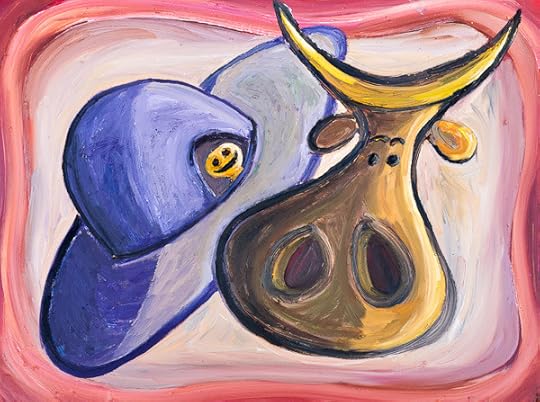
"Cow and UFO", 24″ x 18″ inches, August, 2011, Oil on canvas." Click for larger version.
More info at my Paintings page.
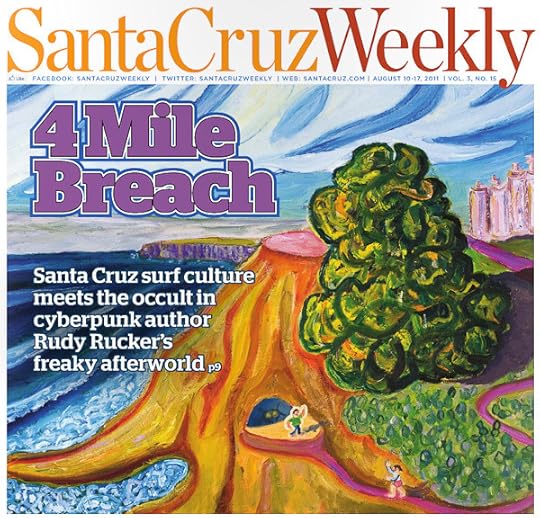
On the local publicity front, the Santa Cruz Weekly is featuring a profile of me with an excerpt of my new novel Jim and the Flims. You can find a PDF of the Santa Cruz Weekly online. It's mainly the same article as was in the Silicon Valley Metro last week, but this version features two of my Santa Cruz paintings as illos.
August 3, 2011
METRO Profile. Summer Art Sale.
Department of Prophet Receives Honor in Home Town:
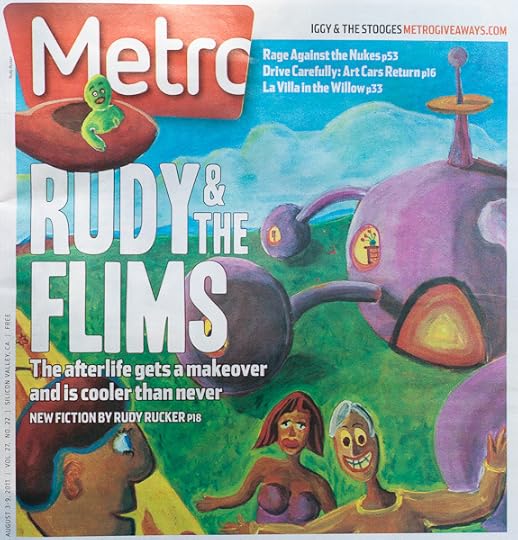
I'm in the San Jose Metro this week, with a profile by Dan Pulcrano, an appreciation by Gary Singh, photos by Felipe Bultrago, and the entire first chapter of Jim and the Flims! I'm really happy about it.
The Metro is a free weekly newspaper, widely distributed around Slicon Valley, and you can get PDFs of the issues online, although just now this new issue isn't on the site yet.
It's cool that they showed some of my paintings in the article—and the one on the front page was "The Clone Garden" which I did while working on Jim and the Flims.
I've been painting more than usual lately. It's because I don't have a novel or even a short story to work on, and I like to have some kind of creative outlet during the day. A way to lose myself in the process of craft.
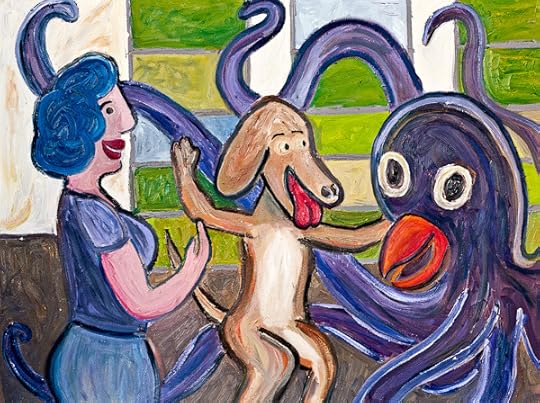
"Noon Meeting", 40″ x 30″ inches, August, 2011, Oil on canvas." Click for larger version.
So here's the latest one, called "Noon Meeting." I started out with a set of pebble-glass windows that I like. They went into the background, the grid of green and yellow rectangles. And I put three characters in front of the windows, happy to be getting together in the daytime, let's say it's at noon. A woman, a dog, and an octopus.
By the way, I feel like I'm accumulating too many paintings in my basement, and I'd really like to sell some. So check out the summer sale prices on my Paintings page!
Coming back to "Noon Meeting," my artist friend Paul Mavrides had suggested that I try using an impasto medium to build up more of a texture on my pictures and I did this with this new one, and it looks good.
This is one of those pictures that is a bit like an unknown parable. But I feel like the three friends are people I know. Indeed, I might be the dog in the middle, bringing the two others together. We used to have a dog who looked a lot like that, his name was Arf.

I told my other artist friend Vernon about the theme of my new picture and he said, laughing, "Ah, yes, the three fundamental elements of any successful painting: a woman, a dog, and an octopus."
I never got to hang out with cephalopods, only glimpsing them when diving, but I often put them in my novels. They're, like, the ideal aliens.
July 28, 2011
Three Questions About Cyberculture
Today's post is the transcript of a short email interview with me by Simone Lackerbauer, who's at the University of Paris working on a thesis about Mondo 2000 and cyberculture. The numbering of the questions and answers (326, 327, and 328) extends the numbering in my unified interviews file, available as a PDF online.

Q 326. You have been writing mathematics books and SF novels, you have published software packages, and you are a painter. How much of your professional activity is related to formal education, how much was just learning by doing or by observing (as with your recent "Stolen Picasso" painting? Do you think there is a difference between the value of things we learn by tinkering and experimenting and the things we learn at school or at university?
A 326. Although I have a Ph. D. in mathematics, I never took a course in computer science or in writing. So I am in many ways self-taught.
I would hasten to add that my years of education did make a difference to me, even in the areas in which I never had any formal studies. A liberal education prepares you to study, to learn, and to form ideas of your own. The intense, focused effort of writing a graduate-level dissertation gives you a sense of how to think hard about a single topic over a sustained period of time.
Writing was the craft I wanted to learn the most, and I got my first start at it simply by writing a lot of letters to my college friends. I used a typewriter, just as I imagined professional writers would do. I had an Olivetti portable. Later, after grad school, I got a rose-colored IBM Selectric, a lovely machine, currently enshrined in my basement.
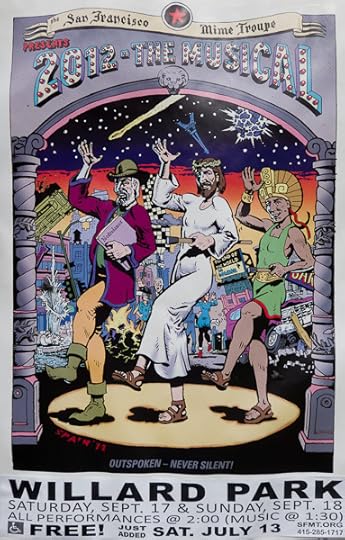
Part of learning to write is a matter of learning to imitate the writers that you admire. I read a lot, and, over the years I imitated Hemingway, Kerouac, Terry Southern, Pynchon, Burroughs, Vonnegut, Phil Dick, Robert Sheckley and many others. Thanks to some fortunate fluke of my mental makeup—and to years of practice—I find it fairly easy to mold words into patterns that I like.
If you read a lot, you develop a large inner library of words and phrases that you love, not to mention a repertoire of story twists, attitudes, and styles of thought. The inside of a working writer's head is like the backstage wardrobe room at a theater. In your apprenticeship you stock the wardrobe room, then you began assembling costumes from it, and perhaps at some point you're designing entirely new garments of your own.
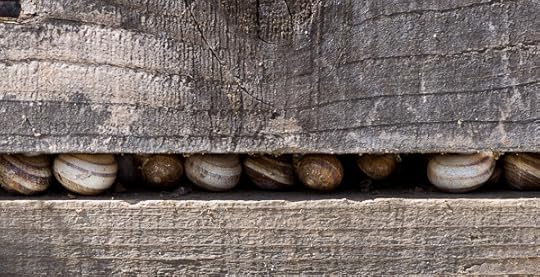
I'm still very much a beginner at the craft of painting, but the process of maturation seems somewhat similar to that of writing. You learn, you copy, you create. I've been going to museums and galleries to look at paintings for forty or fifty years and, as with writing, I have a mental store of effective techniques and imagery that I've observed. Unlike with writing, I'm by no means a natural painter, and creating images that I want is time-consuming. But eventually I can get some things that I like—painting over things, rubbing out false steps, revising the outlines, daubing on new layers to change the shades. The one thing that works to my advantage as an amateur painter is that I have a visual imagination, so I have a good supply of images I want to see.
Touching on another question that you raise—we place the greatest value on the things we discover ourselves. School is really a matter of teaching you how to go about your investigations. The real knowledge consists of the things you find on your own.

Q 327. Someone not familiar with the field of computer science might think it is based on logic and algorithms. Is there anything about computer science that cannot be taught formally? What are the creative aspects of computer science?
A 327. Computer science is a multifarious field—one distinction is between theory and practice. It is in fact possible to write a Ph. D. thesis in computer science without ever writing any substantial programs—a dismissive description of such a thesis is: "proving that two ugly Turing machines are equivalent." That's on the pure theory side of things.
I was a CS professor for about twenty years, and I was always more interested in practice than in theory. That is, I enjoyed crafting programs that do things that are in some way interesting. And I based my theoretical notions on these new programs that I'd made.
In particular, I always liked writing what I call gnarly programs. These involve intricate colored shapes on the display screen that may come to life and dance around. I'm thinking of cellular automata, fractals, chaos, artificial life, and videogames.

I often taught a class on software engineering in which I had the students write videogames. It's very hard to write a lively videogame from scratch—there are exceedingly many technical details that you have to get right. Over the five years, I managed to craft a textbook, Software Engineering and Computer Games, with a framework of C++ code that my students could build upon to get their own programs going, with plenty of little critters racing around. (The book and the software framework are now online for free download. )
I used to tell my software engineering students that learning to program is about learning how to make mistakes faster. Hardly any program ever works immediately. There's always a mistake in it, something wrong. And you have to find the bug and fix it. And then there's a new bug. And you have to fix that. Faster and faster.

Some textbooks make it sound as if software engineering is a formal process of making out lists of specifications, milestones, and the like, the process is also an experiential hands-on endeavor. You don't ride a bicycle by making out lists of part numbers. You have to get on it and lurch around.
There are any number of ways to be creative in CS. In terms of theory, you might come up with a new higher-level way of thinking about computations. In terms of practice, deciding what kinds of programs to create can be creative. Much creativity (and low cunning) comes into play in finding ways to make one's programs run faster. And designing a program's interface is an artful process as well.
Just as is the case for writers and painters, programmers will often find that their projects are mutating while they work on them. Certain pathways close up, and newer opportunities emerge. At some point it can feel as everything you see all day long is in some way part of the creative process—as if everything is helping you to get the project done. This is known as communing with the Muse. And, make no mistake, there is a Muse of programming as well as there are Muses of writing and painting.

Q 328. How would you personally define "cyberculture" and is it what you thought it would be like twenty or thirty years ago? How has the relationship to personal computers, smartphones and other gadgets changed? In what ways is cyberculture relevant for computer science?
A 328. I feel I should pause here and dispel any idea that I'm primarily a computer scientist. That's not the case. Although I was a professor of computer science from 1986 to 2004, and worked as a software engineer at Autodesk in the late 1990s, these were day jobs for me, that is, ways to make money while I pursued my true career—which is writing science fiction novels and popular science books.
The people with the 1990s magazine Mondo 2000 were among the first to form a notion of cyberculture. They picked up on the McLuhanesque notion that the spread of computers was changing our culture. William Gibson's novels involving cyberspace were a big influence as well, as was the burgeoning interest in virtual reality, not to mention the spread of the internet.

In cyberculture both our social lives and our personal images are to some extent delocalized. In part, you and your acquaintances are your blogs, your web pages, your social network posts, your emails. As long as you have access to computer or a smart phone, you can plug into cyberspace.
These days you feel impaired when you can't access the internet—you feel like a nearsighted person who's misplaced their glasses, like a deaf person without a hearing aid, like a musician wearing heavy gloves.
The full-immersion computer-graphical techniques of virtual reality haven't caught on to the extent that was predicted. People are content with the highly detailed worlds of their videogames. The human mind is so labile that you can in fact project yourself into these worlds without having to wear goggles with video screens.
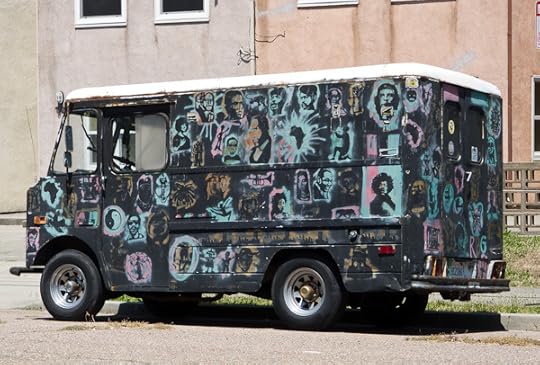
Here in 2011, we're at an awkward point in terms of our devices—you see people staring at the very tiny screens of their smart phones and tapping on the even tinier keys of their virtual keyboards. Clearly this is a defective interface, which may be replaced by voice recognition techniques or by stick-on sensors that might read the subvocalizations in your throat or possibly the brain waves at the base of your skull.
Certainly it's good for the field of computer science to have our daily reality so fully imbued with cyberspace. There's no end to the problems and applications that arise. At some point we might expect to have every physical object be represented in the internet in one way or another.
And, of course, all of this provides rich fodder for science fiction novels such as my recent duology Postsingular and Hylozoic. In these books reality is fully subsumed into a telepathic internet, and every object becomes alive. It may happen yet!
July 21, 2011
Stolen Picasso!
A Picasso painting, "Woman in Blue Hat (Dora Maar)," dated October 30, 1939, was stolen from the Picasso show at the DeYoung Museum in San Francisco last week. And has now been located in the home of a seedy ex-professor, who currently styles himself as a science-fiction writer!!!
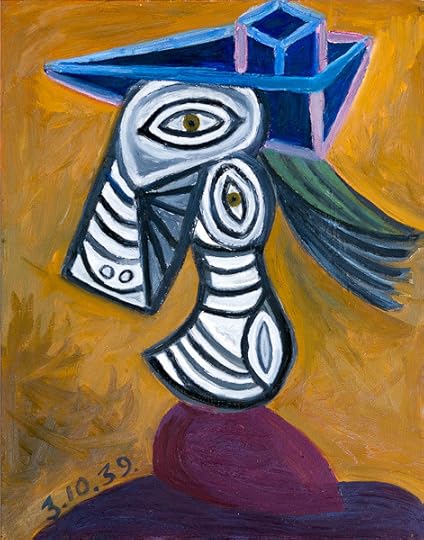
"Stolen Picasso", 18″ x 24″ inches, July, 2011, Oil on canvas." Click for larger version.
Software theft that is. I liked this painting so much when I saw it at the show that I found an image of it on the web and copied it as a kind of homage. And to learn a little more about how Picasso did it. The more I worked on the painting, the more little things I saw. I missed quite a few tricks, but by now I'm happy enough with how it looks, and I can stop. In some way it's become my own. Stolen.

I'm not absolutely saying I might not work on mine some more, though. I like the way Picasso has the mouth pushing out more, and the irises on the eyes, and the interesting shading around the nose. He makes the thing look more like a real face.
I found this image of the original on an article in the Seattle zine The Stranger when this show was in Seattle in 2010. (Our old friend Bethany Jean Clement works at the The Stranger, by the way, so hi, Bethany, in case you go Google-trolling for your name some time and encounter this post.)
While I was at it I prepared my next canvas by painting it gray with the mixed-together left-over paint from "Stolen Picasso." I figure if I have the dark background I can make some lighter things pop hard from the picture plane.

Setting the canvas on an easel to dry a bit in the afternoon sun, and a spontaneous bit of process art emerged: a nice shadow of our phone/cable lines on the cloudy canvas.
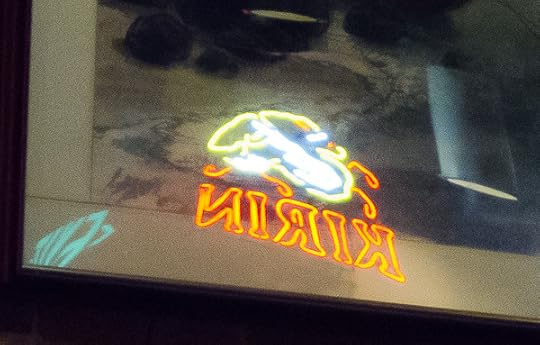
It's all art, isn't it—even a vagrant neon reflection on a bit of glass.

Or three verticals arranged just so in an empty alley, welcoming the manhole cover.
July 20, 2011
The Monomyth and Me
Ten years ago, I was trying to quit smoking, and I'd done a week with no tobacco. I'd also been reading an old paperback of Joseph Campbell's classic book, The Hero With a Thousand Faces, (Bollingen Foundation, 1949) about the Monomyth. Somehow (not being an English major) I'd never read it before. And I began thinking I could use it to help design my next novel—which would turn out to be Frek and the Elixir.
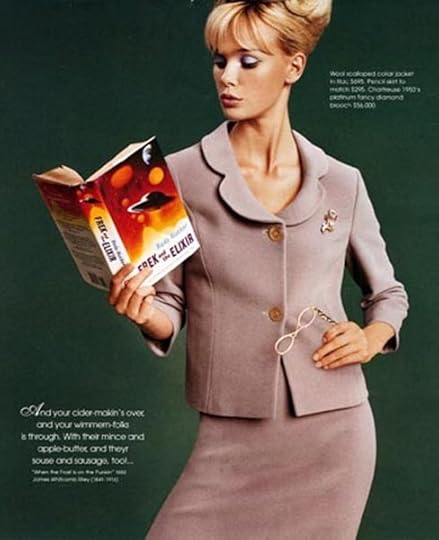
Campbell has 17 stages in the Monomyth, that he breaks into three acts: Departure, Initiation, and Return. The overall arc is fairly clear. A hero or heroine goes to a special place, is transformed, gets something magical, an brings it back.
Departure–
1. Call to Adventure.
2. Refusal of the Call.
3. The Helper (Supernatural Aid).
4. Crossing the First Threshold.
5. The Belly of the Whale.
Initiation
6. The Road of Trials.
7. Meeting with the Goddess.
8. Woman as Temptress.
9. Atonement with the Father.
10. Apotheosis.
11. The Ultimate Boon.
Return
12. Refusal of the Return.
13. The Magic Flight.
14. Rescue from Without.
15. Crossing the Return Threshold.
16. Master of Two Worlds.
17. Freedom to Live.
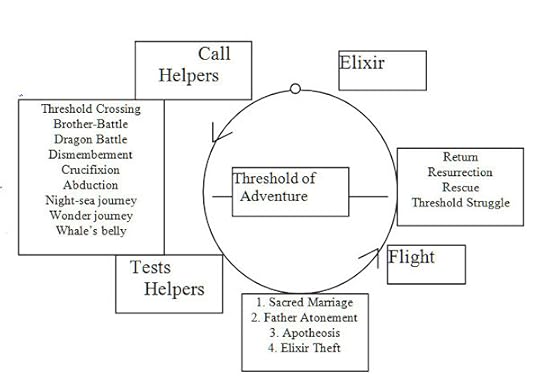
Campbell views the Monomyth as an ongoing process that can repeat itself over and over and over in a person's life, a Monomyth cycle. Indeed each day is in some degree a circle around the Monomyth, I've started thinking, perhaps even each hour or each breath. The cycle has four stages that might be labeled: Call | Tests, Flight | Elixir, with the "|" indicating passage across the Threshold.
A number of women have remarked to me that the monomyth is sexist and that I should think of a version based on a heroine instead of a hero. There's discussion of this point in the critical literature as well. I'll make some remarks about a Monomyth for a heroine further down the page.

How I Decided to Use the Monomyth for Frek and the Elixir
On April 20, 2001, as a reward for not smoking, I'd meant to drive to Santa Cruz and go biking, but it was raining too hard, and I stopped at the summit of the Santa Cruz Mountains on Rt. 17. I did a U-turn and went into a road-stop pizza-restaurant I'd never been in. Doing the turn I was slightly uneasy about the attention paid me by a lurking highway patrolman.
The inn was rustic and cozy. Oakslab table top, rocky walls, pot-belly stove, five Latinos off work for the day playing pool. With Campbell in mind, they took on a mythological status, as if they were a troop of Nibelungen gnomes. The Chinese innkeeper and his wife seemed mythic as well, not quite friendly, the same kind of innkeepers found in tales from earliest times.
I sat there taking it in, hand-writing some notes on Campbell that I typed out above. I thought of a tripping acidhead I'd met at a party in Mill Valley saying, "Let's be mythic." How trippy it indeed is to see the world as the working of the Monomyth.

My Boon just then was a Styrofoam cup of coffee I got from the Goddess and Father, i.e. the innkeeper and his wife. The policeman who might have questioned me as I made my turnaround in my car was a Guardian. I decided I'd like to write a novel that is explicitly a seventeen-chapter Campbell Monomyth. I'd set it in the year 3000.
And, thinking ahead a little…I realized that he Helper could be the little dwarf or magic animal of fairy tales. The Helper gives the hero a magic tool like a cloak or an amulet. I was seeing my hero Frek's Helper as a cuttlefish. "Demure" just like Kerouac always calls Dean Moriarity.
I'd viewed some cuttlefish at the Monterey aquarium only a few days earlier, and the cuttles did indeed look demure, their bunched tentacles pointing tidily down, their hula-skirt a wavering about their middle. Neal Cassady as a cuttlefish, yas. Actually, however, my Frek's Helper turned out to be a grulloo, who was indeed like a gnome.
Synchronicity alert: the name of the roadhouse where I committed to using Campbell's 17 stages of the Monomyth for my novel design was…Casa de 17.
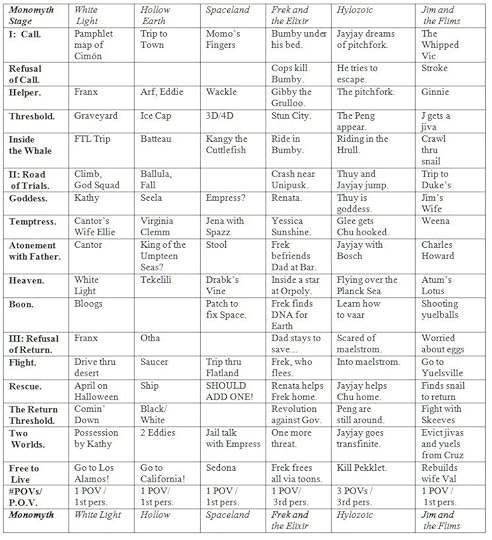
The Monomyth in my Other Novels
After I wrote Frek and the Elixir, I realized that, if closely examined, most of my novels seemed to have a Monomyth structure. I mapped this out for some of them, although inevitably one could argue about nearly every entry. I never did get around to fitting all of the novels into the table. (Grad students! Looking for an easy thesis in Science Fiction Studies? Expand upon the table shown above!)
One thing about Campbell's Monomyth that initially struck me as odd or even ludicrous was the "Belly of the Whale" stage. I mean, up to then it's fairly reasonable, just things like the Call, the Helper, and so on. And then suddenly a Belly of the Whale?!?!
But, in examining my novels, I saw that the Whale thing really does come up very often. It's an archetype that I myself use in perhaps every one of my books. The charcter gets inside something and they go somewhere. Inside an alien, inside a UFO, inside a force field.

[Painting by Sylvia Rucker, "Kate Croy," acrylic, 12" x 17", 1975]
Monomyth for a Heroine
I mentioned above that we need to think about the Monomyth for a heroine. Campbell doesn't work this out in his book, although I would suppose that he talked about it in his seminars. Certainly the hero and heroine archetypes overlap, but you would at least have to change the "Nursery Triangle" stages:
Man: 7. Goddess —> 8. Temptress —> 9. Atonement with the Father
Woman: 7. Divine Bridegroom (Prince Charming) —>
8. Seducer Shows True Colors: Bully, Abuser, Bluebeard —>
9. Atonement with the Mother

More detail on changing the three stages 7, 8, and 9 so as to tailor the Monomyth to fit a heroine instead of a hero:
7. The Goddess || the Bridegroom] The Goddess: The nurturing mother, viewed at a higher plane than sexuality. I have the mental image of a mother I saw with her baby alone on the beach at Lover's Cover in Pacific Grove near Monterey. "Just Mommy and Me." Possibly goddess appears as an ugly or perhaps "dead" woman whom you kiss to deliver and make beautiful. And the the two mother aspects are united, the nurturer and the sex partner: The Wife. For a heroine, you'd switch this to a caring, but distant, father brought close. The ideal suitor.
8. The Temptress || The Tyrant Coupled with or based on or evoking a disgust with the flesh. The punishing, ignoring, sexually active mother. The wife when you're tired of her and she's tired of you. The Millstone, the Termagant, the Virago, the Quagmire. For a heroine, this is the Rapist or Pimp, the one who exploits sex against its natural purpose of love and procreation. The Abusive Husband.
9. Atonement with the Father || Atonement with the Mother. The father or mother may appear as a beggar. Or even ogre as in "Jack and the Beanstalk." True success is peace with father (mother), not their destruction. You get power.
And maybe there are other changes. One would have to look carefully at a bunch of myths about heroines. Persephone comes to mind, with her task of separating millet from sand and the ants who help her. And what about Virgin Mary? In the story of the Virgin Mary, the big deal is having that divine son. Is there anything like that in the Myth of the Hero? Maybe equate the Divine Son with the Ultimate Boon? Or is the Virgin Mary an anomalous tale?
Perhaps a completely different sequence of stages than what Campbell uses would be a better fit for a womanly Monomyth. In this context, I'll mention The Heroine's Journey by Maureen Murdock.
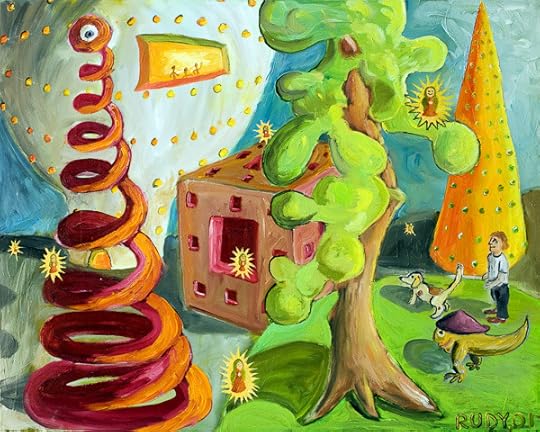
A Frek 2?
You can find more of my thoughts about specific stages of the Monomyth in my Writing Notes for Frek and the Elixir, available as a free PDF on my Writing page.
Looking ahead, near the end of the Monomyth, we have Stage 14. Master of Two Worlds. I see the Higher Kingdom as a hidden aspect of our world. The character has ongoing lasting access to the Beyond. The two worlds become one. The character presents an elixir which heals and restores the world— for now.
And then, 15. Freedom to Live, the character becomes an anonymous wanderer. His or her work continues. Life goes on. And then…
The Sequel! So the reason I'm doing this mental exercise is that I'm considering a sequel to Frek and the Elixir.

In 2005, I was thinking of doing a Frek sequel, and discussing it with my Tor editor, David Hartwell, and kind of bemoaning the fact that I'd used the Monomyth and that now I wouldn't know how to structure the sequel. And Dave was like "It's the Monomyth, Rudy. That means you use it over and over and over!"
Aha.
July 16, 2011
V-Bomb Blast, Painting #3 for my Turing Novel
I did three paintings for my novel, The Turing Chronicles, "Turing and the Skugs," "A Skugger's Point of View," and "V-Bomb Blast, " which I finished today. You'll find it at the bottom of this post. As always, more info on my Paintings Page
Note that The Turing Chronicles treats a timely theme, as 2012 is the centennial of the man's birth, and has been dubbed the Alan Turing Year, with a number of conferences and events planned for that year.
For those of you who just tuned in, Alan Turing was one of the primary inventors of today's computers. He is believed to have died wretchedly in 1954, a suicide persecuted by the British authorities for his homosexuality. The Turing Chronicles proposes that Turing's supposed death was a cover-up, and that the man himself escaped to the open city of Tangier.
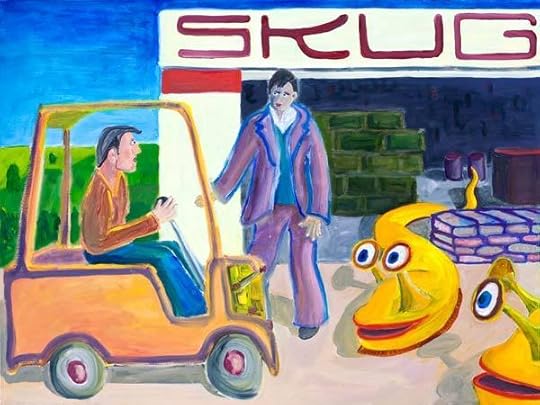
"Turing and the Skugs", 40″ x 30″ inches, Oct 2010, Oil on canvas." Click for larger version.
For the purposes of The Turing Chronicles, I'm supposing that Turing has carried out some biochemical experiments leading to the creation of slug-like creatures called skugs. In "Turing and the Skugs," we see Turing encountering a handsome man who may well become Alan's lover. In my novel he's rather promiscuous.
In Tangier, Turing meets the Beat writer William Burroughs and they become lovers. Turing invents a parasitic biocomputational organism called a skug. Both he and Burroughs welcome skugs into their bodies, thereby becoming skuggers. Skuggers enjoy both telepathy and shapeshifting, that is, a protean ability change their bodies' forms.

"A Skugger's Point of View", 40″ x 30″ inches, January, 2011, Oil on canvas." Click for larger version.
In "A Skugger's Point of View," I wanted to render an extreme first-person point of view in which we see the dim zone around a person's actual visual field. Turing has become a mutant known as a "skugger," and he has the ability to stretch his limbs like the cartoon character Plastic Man. He is traveling across the West with two friends, a man and a woman.
Turing's cohort is being attacked by police, one of whom bears a flame-thrower. Turing is responding by sticking his fingers into their heads, perhaps to kill them, or perhaps to convert them into skuggers as well. We can see Turing's arms extending from the bottom edge of his visual field. Even though it's not quite logical, I painted in his eyes as well because they make the composition better..
Turing and Burroughs have been busy spreading the skugger infestation to the people around them. My novel takes on aspects of a Fifties invasion story such as The Invasion of the Bodysnatchers. The difference is that The Turing Chronicles is told from the point of view of the mutants themselves, and the alienated mutants are a positive force. Society at large becomes consumed by a hysterical hatred of the skuggers, and the authorities seek to exterminate them.
The subtextual kicker is that this mirrors what happened culturally as the 1950s segued into the 1960s. Outcasts such as Beats, artists, radicals and homosexuals began to gain more control, sparking reactionary efforts to suppress them.
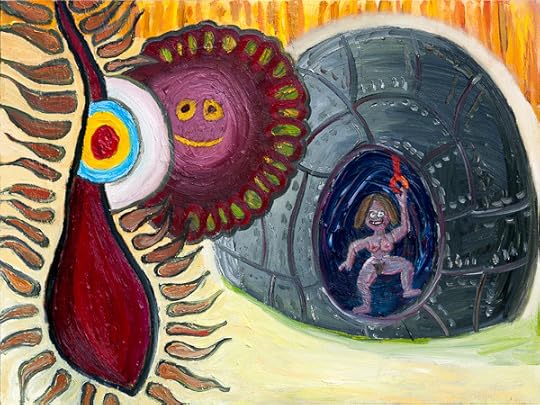
"V-Bomb Blast", 40″ x 30″ inches, July, 2011, Oil on canvas." Click for larger version.
Of course no Fifties-style SF novel is complete without a nuclear weapon. At the climax of The Turing Chronicles, Turing and Burroughs are in Los Alamos, New Mexico, working to block the detonation of a V-bomb, which will emit rays to annihilate the skuggers wholesale.
Sacrificing his own life, Turing crawls inside the weapon before ignition. Upon the V-bomb's detonation, he uses his higher powers to alter its radiation—preserving the lives of his fellow skuggers while removing their parasitic skugs. And in an afterword, Burroughs explains what happened.
The "V-Bomb Blast" painting doesn't exactly depict what I'm talking about. But reading from right to left, you can view it as three stages of the V-bomb—on the right, someone (who I happened to paint as a woman) is inside the V-bomb, about to pull the detonation cord. In the middle is a semi-happy face nuclear explosion. Oddly enough, the V-bomb fireball shrinks instead of expanding.
And on the left, we see the explosion slipping through a rent in the fabric of reality. "Turing died that we may live."
July 13, 2011
Limited Edition of NESTED SCROLLS
My autobiography, Nested Scrolls, is out in a limited edition from PS Press in England. They're selling hardbacks and a signed collector's edition.

I just got my copies yesterday which was, synchronistically, the day I finished the first draft of the next book in the pipeline, The Turing Chronicles.
Note that PS used one of my paintings, "Surfin Tiki" for the cover, and my painting "Jellyfish Lake" for the endpapers. They put together a very nice looking book. The Tor edition will look more or less the same on the inside, although it will have a different cover and no colored endpapers.
Starting on December 6, 2011, Nested Scrolls will also be available in hardcover and ebook editions from Tor Books. I see it already listed on Amazon, Barnes&Noble, Borders, and other sites selling books online.

[By the way, we're not so fond of Amazon in California as we used to be, now that they want to fund a ballot initiative to block our state from collecting sales tax from them…and now that they've stopped paying "finder's fees" to the so-called associates (such as bloggers) in California who link to their site.]

But never mind such mundane considerations. The mothership of Nested Scrolls is launched. Odd than anyone might ever have mistaken it for a hat!
To fill out today's post, I'm printing some excerpts from my Notes for Nested Scrolls document. You can read this whole document for free online as a PDF, see the link off my Nested Scrolls page.
By the way, when I started writing these notes, I still wasn't quite sure if I was working on an autobiographical memoir…or on a transreal novel.

July 11, 2008.
Who would really want to read a memoir by me, after all? It's not like I've gotten a lot of emails from people who have read the existing autobio note online.
There should be some riddle whose answer I'm seeking by writing the memoir—or the memoir-like novel. What is reality? What's the point of my life? How can I be happy? What did I learn by writing thirty books? What's the missing book that I need to write? How is it possible to write at all? Can I create a completely pure work of literary art? What has it been like to be alive? What was the point?

July 12, 2008.
Looking around Borders Books today, I was thinking about what kinds of memoirs get published. David Sedaris and Augusten Burroughs have a whole thing going with rueful tales of personal dysfunction. Back in the 1930s, Robert Benchley, James Thurber and Dorothy Parker were doing something similar.
Another angle is to present yourself as the Witness to History—for me, this might be the Silicon Valley thing or the cyberpunk thing, though people aren't responding much to the Silicon Valley idea when I suggest it. It's like people are sick of Silicon Valley. Maybe if I could clearly cast the memoir as evocations of a bygone era—which certainly it would be. In this context, I think of the Vanished Wild West.
The point of writing a memoir would be to entertain myself, and to gain a bit more self-knowledge. To have some fun. In certain lights, doing a memoir seems easier than grinding away on another novel. But maybe not.
Mainly I want to write, and I don't care all that much what it is that I'm writing.

July 17-26, 2008.
Back to the current obsession—why bother writing an autobio? What would I get out of it? Self-knowledge. Bragging pleasure. Self-guidance. Publicity.
It's mattering less and less to me if I actually do write a memoir. There's such a powerful "why bother" haze surrounding any plan for a memoir.
It might really be more productive to write another novel. Or maybe just a couple of stories first. At the very least, I'm writing in this Notes document.
I'm writing almost at random in these notes. Which could be a good thing. I've heard it said that writers are at their best when they have no idea what they're doing.
William Blake, The Marriage of Heaven and Hell,: "If the doors of perception were cleansed every thing would appear to man as it is, infinite. For man has closed himself up, till he sees all things thro' narrow chinks of his cavern."
I feel like this is getting nowhere. But you never know.

July 26, 2008.
Today's title for the book is Nested Scrolls, a phrase I like because it describes the chaotic, self-organizing, artificially alive Belousov-Zhabotinsky simulations that I love. And "scroll" is good, as it refers to a document or even a sacred text, and if the scrolls are "nested" that's fractal and self-referential and heavy.
I could even get literal with the title, and have the book in the form of a memoir that an aging man is trying to write, and he begins finding extra stuff in the document. Maybe he can somehow zoom in—it's an electronic document—and he sees stuff that he doesn't remember writing. And he goes into time-travel flashbacks. And maybe some characters from the past show up. Nested Scrolls.
July 12, 2011
Finished 1st Draft of THE TURING CHRONICLES
July 9, 2011
I've been working full-bore on The Turing Chronicles for a little over a year now. As of yesterday, my novel file is finally longer than my Notes file! 81,621 words in the Novel file versus 80,750 words in the Notes. A turning point. Although the Notes could yet pull ahead again.
I'm on the train, going up to San Francisco for a night today, seeing John Shirley read tonight, and reading at Borderlands tomorrow. Will bring the laptop and keep the fire going. I'll sleep at my son's house in Berkeley, even though he and the family won't be there tonight.

July 10, 2011.
In the morning, alone in Rudy Jr.'s house, I did some work on the novel and essentially finished it.
First I had a false-start idea for Chap 17: V-bomb. But I realized that wouldn't work. Too complicated. So I made it simpler. It's all about simplification near the end.
I wrote the V-bomb chapter right through to the ending. Hooray! I'm almost done. I just have to add Chap 18: "Last Words," supposedly by William Burroughs. I was really happy at this point. I walked to the BART stop and a homeless guy looked at me and said, "You the happiest man I see today!" And he was right, I was grinning, aglow, joyful.

One more thought I had later that day: For Alan to effectively modulate the V-rays, and to not hamper the explosion, he should dematerialize into matter-waves right before the explosion.
In the afternoon, I was hanging out on Valencia Street in SF with my artist friend Paul Mavrides, telling him about the plot of my novel, and about the last scene I'd just written and about my recently conceived tweak. Paul was laughing in a friendly way. "So that's the perfect way for you to distribute your ideas from now on. Dematerialize into matter waves and modulate the V-rays."

July 11, 2011.
Okay, tonight I wrote "Last Words," the last little chapter of The Turng Chronicles. I was sitting in my California-Craftsman-style La-Z-Boy recliner armchair in the living-room with Sylvia reading on the couch. The book's first draft is done. Calloo, Callay!

July 12, 2011.
On the morning of July 12, I lay out on my yoga mat in the back yard and marked up the last two chapters two times, retyped them twice, then went over the final chapter onscreen one more time. And fixed a last To Do item. I think it really is done now, although of course I'll reprint the final chapter one or more times.
And then I'll have to do the whole book printout and the full revision thing. But for now it's good enough to mail to an editor. Over 85,000 words, as planned. I wrote nearly 4,000 words in three days. Yeah, baby.
Finis coronat opus.
July 9, 2011
JIM AND THE FLIMS Reading, now with Podcast
[Added on Monday, July 11, 2011] Here's a podcast of my reading on July 10: the first chapter of Jim and the Flims with some Q & A. By the way, the station also has a podcast (made by Rick Kleffel) of reading I did back in January from my forthcoming autobiography Nested Scrolls on "The Birth of Transrealism". You can click on the icon below to access my Feedburner podcast station.
My publisher and editor Jeremy Lassen was there yesterday with Liz Upson and Tomra Palmer of Night Shade Books, which was nice.

And here's the assembled audience.

And I was glad to have fellow writer John Shirley and my artist pal Paul Mavrides there, too.

[Now back to the old post...]
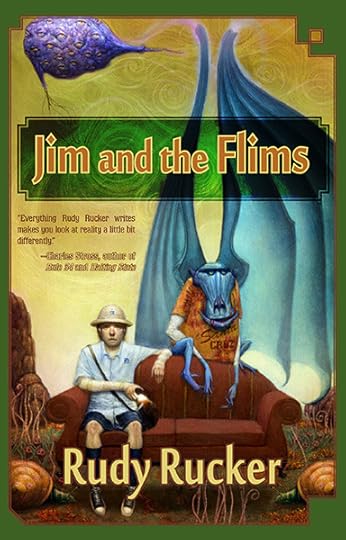
Jim and the Flims, my fantastic novel of Santa Cruz and the afterworld has appeared from Night Shade Books. See my JIM AND THE FLIMS page for more info.
On Sunday, July 10, at 3:00 pm, I'll be giving a reading from Jim and the Flims at the fabulous and cozy Borderlands Books (and cafe) on Valencia Street in San Francisco. We'll have a Q & A session after the reading, and we'll be giving away a large, high-quality art print of one of my paintings.
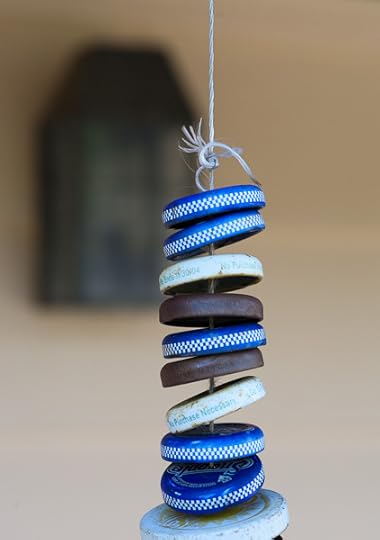
Get in your flying saucer and come on over.
JIM AND THE FLIMS in San Francisco, Sunday

Jim and the Flims, my fantastic novel of Santa Cruz and the afterworld has appeared from Night Shade Books. See my JIM AND THE FLIMS page for more info.
On Sunday, July 10, at 3:00 pm, I'll be giving a reading from Jim and the Flims at the fabulous and cozy Borderlands Books (and cafe) on Valencia Street in San Francisco. We'll have a Q & A session after the reading, and we'll be giving away a large, high-quality art print of one of my paintings.

Get in your flying saucer and come on over.
Rudy Rucker's Blog
- Rudy Rucker's profile
- 583 followers





